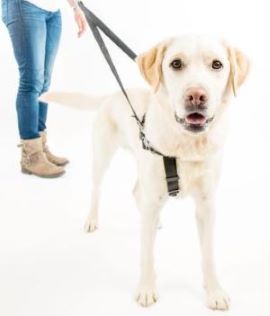A properly fitting harness could be the difference between your dog walking happily alongside you on a loose leash or pulling a Houdini and disappearing down the street.
WHY SHOULD MY DOG WEAR A HARNESS OVER A COLLAR?
If your dog is an escape artist or a puller, or if you’re training or lifting your dog, your dog should probably wear a harness. When a dog pulls on a normal collar, they tend to choke themselves. That pressure on their trachea (throat) can damage it and cause breathing problems. Harnesses are more comfortable and much safer for dogs that pull, they distribute pressure across a larger, less sensitive area (the chest).
HOW TO MEASURE YOUR DOG FOR A HARNESS
There aren’t standard dimensions for dog harnesses; a medium-sized dog harness from one company could be considered an extra-large at another. Before you can choose the right harness for your dog, you’ll need to take a few measurements:
Weight: Your dog’s weight can help you determine which harnesses will be strong enough for them to wear. With other dog harnesses, a dog that’s 20 pounds over their weight limit could break them when pulling or lunging after a squirrel. We offer Freedom No-pull harnesses that have been tested to pull up to 3800 lbs, meaning they’ll never break or fray no matter how hard your dog pulls.
Chest: Using a soft tape measure (or piece of string), measure all the way around the LARGEST part of your dog’s chest. Starting at the bottom of their rib cage, bring the tape up and over their back, and then back down to where you began.
Neck: You’ll need to know your dog’s neck size for some types of harnesses. To get this number, simply wrap your tape measure around the THICKEST part of your dog’s neck.
If your dog is between sizes, select the next size up.
HOW SHOULD A DOG HARNESS SHOULD FIT
There are many different kinds of dog harnesses, and each type of harness will have a slightly different style and fit. In general, a dog harness should fit snug, but not too tight. It should be tight enough that your dog can’t back out of it, and the ring (that you clip the leash to) should sit higher on their chest. Just like with a collar, you should be able to fit two fingers (but only two!) between the harness and your dog.
SIGNS YOUR DOG’S HARNESS ISN’T FITTING RIGHT
Your dog’s harness isn’t fitting right if:
- They can step or wiggle out of it
- They’re chafing under the armpits or around the harness
- They’re losing fur/hair around the harness area
- The chest strap loosens on your walk
- The back piece rotates to the side
If your dog is being resistant to walking (they just stand there on the sidewalk and don’t budge) or if they’re putting up a fight when it’s time to put on their harness, it might be because the harness doesn’t fit right!
Think about wearing a bathing suit that’s way too tight and how it digs into and rubs against your skin. If that was your only bathing suit, you probably wouldn’t want to go swimming. In your dog’s mind, going on a walk just isn’t worth the discomfort of wearing their too-tight harness.
WHY A PROPER FIT MATTERS
Not only can a poor-fitting harness cause your dog discomfort and pose a safety issue for dogs who can wiggle out and break free, but it can also cause medical problems too. If your dog’s harness is too small/tight, it can restrict their natural movements. Their stride gets thrown out of whack and they start using their muscles incorrectly, causing unnecessary stress on their joints and bones.
Shop our high-quality dog harnesses today!

